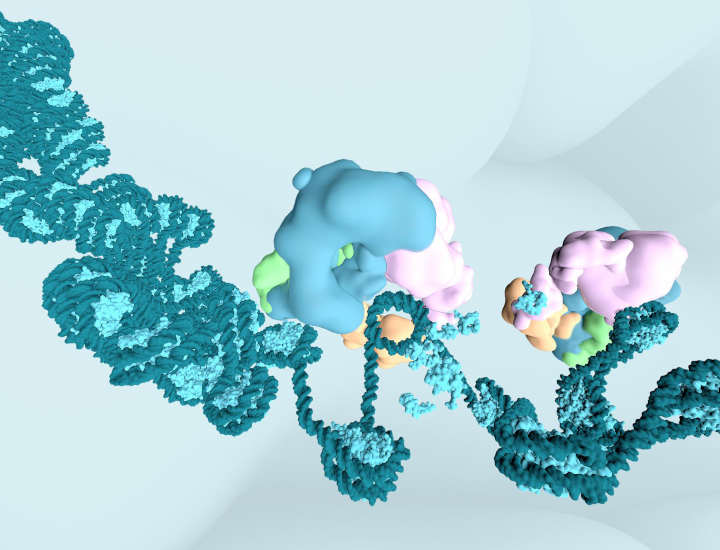Silencing BAF complex function results in almost a total loss of chromatin accessibility at BAF-controlled sites, a new paper1 has found.
When human cells need to acclimate to a various external influences, the BRG1/BRM-associated factor (BAF) complex is central to the process – it regulates the accessibility of the DNA and the information stored in it. In one out of five human cancers, a mutation is found in one of the BAF complex genes.
Scientists from the research group of Stefan Kubicek at the CeMM Research Center for Molecular Medicine of the Austrian Academy of Sciences have investigated this complex in more detail using novel techniques and were able to demonstrate how rapidly changes in the BAF complex genes influence the accessibility of DNA.
Chromatin Remodeling Complexes
Chromatin, the material that makes up the chromosomes, is a key constituent of the cell nucleus. It organizes the roughly two meters of human DNA in such a way that certain genes are activated or deactivated depending on the cell type. The smallest “packaging unit” of chromatin is the nucleosome, consisting of 146 base pairs of DNA wrapped around a histone octamer.
Whenever cells need to adapt, changes to chromatin are necessary. The alterations are carried out by various enzymes, including chromatin remodeling complexes, which use the energy of adenosine triphosphate (ATP) to move nucleosomes along the DNA or to remove them completely.
One important chromatin remodeling complex is the BAF complex. It consists of up to 14 subunits encoded by 29 genes which interact in different combinations.
Previous studies2 have found mutations in certain subunits of the BAF complex in numerous cancers. In their recently published study, Kubicek and his research group investigated the direct effects of changes in the BAF complex on DNA accessibility.
Loss Of Accessibility
To see the functions of chromatin remodeling complexes, genetic methods are used which can inactivate these proteins within 3-5 days. But because of the slowness of these technologies, they were unsuited to determine the immediate effects of changes to the BAF complex on DNA accessibility.
So the scientists Sandra Schick, Sarah Grosche and Katharina Eva Kohl from Kubicek’s research group relied on a so-called degron system.
Here, too, we use CRISPR genome editing. But instead of destroying a BAF subunit, we fuse it with a small protein called a ‘dTag’. By adding a specific active substance, we can then recruit the ‘dTag’-tagged subunit to components of the cellular ‘waste removal’. The labelled BAF subunit is then degraded within one hour. This makes it possible to precisely observe whether and how accessibilities subsequently change,
explained the study authors.
Our study has shown that removing a specific subunit of the BAF complex immediately leads to a loss of accessibility to certain DNA regions. The effect appears immediate, hinting that the cell cycle plays no role in this process. We were also able to confirm these results with pharmacological inhibitors of the BAF complex, which showed particularly fast effects. We assume that processes similar to those in our model system also play a role in carcinogenesis when mutations of a subunit of the BAF complex occur in cells for the first time,
Stefan Kubicek added.
A Lethal Loss
In previous studies, the research group had investigated how different genes within the BAF complex interact. This showed that cells in which only a certain BAF subgroup has a mutation and reduces DNA accessibility can continue to live and grow.
In some cases, however, the additional deactivation of another, specific subgroup leads to cell death. This interaction of specific genes is called synthetic lethality.
A known synthetic lethality exists in the two genes SMARCA2 and SMARCA4. Cells can tolerate the loss of either of these genes but die as soon as both are mutated. Mutations of SMARCA4 have been found to be particularly common in cancer cells.
Specific SMARCA2 inhibition has the potential to exploit synthetic lethality to specifically kill these SMARCA4-mutated cancer cells without damaging healthy cells. In their current study, the study authors observed the immediate effects of synthetic lethality.
We wanted to know what happens when we remove both subunits,
said co-first author Sandra Schick. This showed that compared to the loss of each individual subunit, even more regions of the DNA lose accessibility, especially those that are crucial for cell identity.
ATP-dependent Remodeling
They saw that so-called ‘super-enhancers’, very active gene regulatory regions, only lose their accessibility when they triggered this synthetic lethality, in other words when they lose both SMARCA4 and SMARCA2.
In addition, the scientists tried to trigger the same effect using pharmacological substances. These inhibit the activity of the BAF complex and prevent it from moving nucleosomes.
Our results show that maintaining the accessibility of BAF-controlled sites in the genome requires constant ATP-dependent remodeling. This means that the BAF complex needs constant energy provided by ATP to move nucleosomes and thus maintain access to the DNA. Complete abrogation of the BAF complex function results in a near-total loss of chromatin accessibility at BAF-controlled sites,
Stefan Kubicek said.
The research was supported by the Austrian Federal Ministry for Digital and Economic Affairs and the National Foundation for Research, Technology, and Development, the Austrian Science Fund and the European Research Council (ERC) under the European Union’s Horizon 2020 research and innovation programme.
- Schick, S., Grosche, S., Kohl, K.E. et al. Acute BAF perturbation causes immediate changes in chromatin accessibility. Nat Genet (2021). ↩︎
- Hodges, C., Kirkland, J. G. & Crabtree, G. R. The many roles of BAF (mSWI/SNF) and PBAF complexes in cancer. Cold Spring Harb. Perspect. Med 6, a026930 (2016) ↩︎
Related Posts:
- Astrocytes Regulate Suprachiasmatic Nucleus Circadian Rhythms
- Gene Mutation Tied to Reckless Drunken Behavior
- Treacher Collins Syndrome: Three Genetic Mutations Identified As Cause
Last Updated on December 14, 2022
